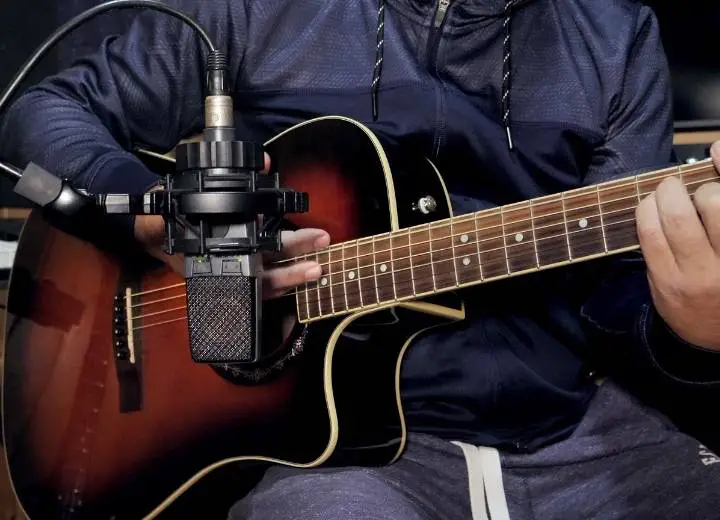
It’s time to include some guitar tracks in your playlist.
However, recording acoustic guitar mono vs stereo, which method offers higher quality sound? What is the difference between mono vs stereo?
If you are serious about your project, this article is what you are looking for.
Read on, and you will find out the correct solution.
What is mono recording?
Any music track produced utilizing only one audio channel is monophonic (mono) recording.
For example, recording an acoustic guitar with only one microphone will result in a mono recording. To make a mono guitar track, you can record one track with one mic solely on a single channel.
During the playback of mono tracks, both speakers will produce identical audio output.
What is stereo recording?
A stereophonic (stereo) sound needs to utilize several channels, generally using multiple microphones and speakers.
You may pan the music with stereo tracks, resulting in different audio signals from the left and right speakers. This sound is similar to how a listener hears music during a live performance.
Differences between Stereo and Mono
#1. Function
To record and replay an audio track on a stereo signal, you might need two audio channels.
Meanwhile, mono signals need recording and playing back using just one audio channel. For the listeners, however, the outcome is quite different.
You may see a video that compares mono and stereo guitar recordings.
#2. Width
Recording an acoustic guitar will provide breadth to the mix. You may find it useful in compositions with few other instruments.
However, sometimes you use the guitar as the main instrument in a minimalist arrangement. In this case, the stereo may be quite effective.
#3. Volume
A volume meter, in theory, will show stereo and mono songs as having the same numerical level.
A mono-tracked guitar seems to be louder than a stereo one by the human brain.
#4. Imaging
While listening to a song through earphones or production monitors spaced properly apart, the vocals always are in the middle. Stereo imaging, a key component of audio playback, is the reason behind this.
Our brain and ears have developed to be able to distinguish between sound direction and distance.
The ability to detect and identify sound effects in realistic audio recordings. Mixing producers utilize it to generate a realistic sound reproduction comparable to what we hear at a live event.
We can use stereo imaging to accomplish this. It makes the mix more enjoyable and appealing to the audience when done correctly.
However, because this is a large field with a lot of material, it is preferable to save it for another post.
What to choose: recording acoustic guitar mono vs stereo?
The most popular technique for novices or home-recording aficionados to record guitar is using a mono recording with a mic.
Any dynamic mic can capture a mono track. It is simple, cost-effective, and simple to use. If you’re a composer or your track is focused on the guitar without other components, you might like to stereo mic the acoustic.
It may need the use of more complex recording techniques. A stereo record will need some microphone positioning expertise. The most popular technique to employ two mics for stereo audio is the distanced technique. In some cases, the coincident pair approach can be a good method.
If the guitar is the centerpiece of the piece, it will take center stage.
It would be best if you captured it in stereo utilizing close mics stereo methods in this situation. A basic understanding of mic positioning and the proper space between microphones is necessary for all stereo procedures.
You won’t get any phasing difficulties because of the distance. The term phasing problems refers to a minor delay in timing. This problem results from the microphone’s separation from the real sound source.
Phasing difficulties are unpleasant to listen to. They also degrade audio quality, and thicken the blend.
Most novices choose to record a guitar in mono since it takes up less room in their recording. It is simpler for you to set up a single microphone as well. The necessary equipment is less expensive as well. Moreover, there are no difficulties with phasing to be concerned about.
Furthermore, you may always double track and pan several guitar recordings. This is to broaden your composition.
Similarly, you can always record the guitar in stereo. Then, just use only one microphone afterward. However, before you begin recording, double-check that the mic is in the best possible location.
Conclusion
All in all, if the guitar is only a part of a mix, you should record it in mono. On the other hand, you should choose stereo if you produce solo guitar audio or in a sparse mix.
If you need any further information, please feel free to ask. We will be right back to assist you.
Thank you for reading!
